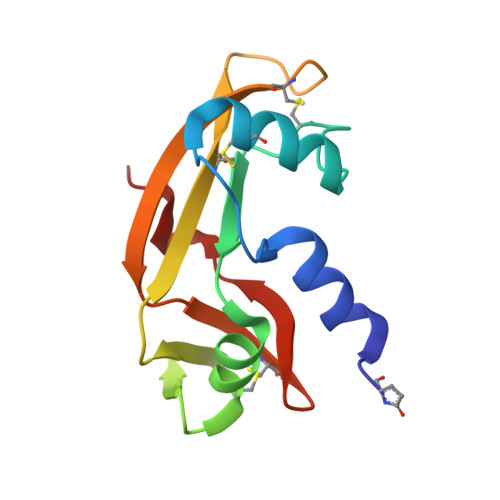Crystallographic studies on the role of the C-terminal segment of human angiogenin in defining enzymatic potency.
Leonidas, D.D., Shapiro, R., Subbarao, G.V., Russo, A., Acharya, K.R.(2002) Biochemistry 41: 2552-2562
- PubMed: 11851402
- DOI: https://doi.org/10.1021/bi015768q
- Primary Citation of Related Structures:
1K58, 1K59, 1K5A, 1K5B - PubMed Abstract:
Human angiogenin (Ang) is an RNase in the pancreatic RNase superfamily that induces angiogenesis. Its catalytic activity is comparatively weak, but nonetheless critical for biological activity. The crystal structure of Ang has shown that enzymatic potency is attenuated in part by the obstructive positioning of Gln117 within the B(1) pyrimidine binding pocket, and that the C-terminal segment of residues 117-123 must reorient for Ang to bind and cleave RNA. The native closed conformation appears to be stabilized by Gln117-Thr44 and Asp116-Ser118 hydrogen bonds, as well as hydrophobic packing of Ile119 and Phe120. Consistent with this view, Q117G, D116H, and I119A/F120A variants are 4-30-fold more active than Ang. Here we have determined crystal structures for these variants to examine the structural basis for the activity increases. In all three cases, the C-terminal segment remains obstructive, demonstrating that none of the residues that has been replaced is essential for maintaining the closed conformation. The Q117G structure shows no changes other than the loss of the side chain of residue 117, whereas those of D116H and I119A/F120A reveal C-terminal perturbations beyond the replacement site, suggesting that the native closed conformation has been destabilized. Thus, the interactions of Gln117 seem to be less important than those of residues 116, 119, and 120 for stabilization. In D116H, His116 does not replicate either of the hydrogen bonds of Asp116 with Ser118 and instead forms a water-mediated interaction with catalytic residue His114; residues 117-121 deviate significantly from their positions in Ang. In I119A/F120A, the segment of residues 117-123 has become highly mobile and all of the interactions thought to position Gln117 have been weakened or lost; the space occupied by Phe120 in Ang is partially filled by Arg101, which has moved several angstroms. A crystal structure was also determined for the deletion mutant des(121-123), which has 10-fold reduced activity toward large substrates. The structure is consistent with the earlier proposal that residues 121-123 form part of a peripheral substrate binding subsite, but also raises the possibility that changes in the position of another residue, Lys82, might be responsible for the decreased activity of this variant.
Organizational Affiliation:
Department of Biology and Biochemistry, University of Bath, Claverton Down, Bath BA2 7AY, UK.
















